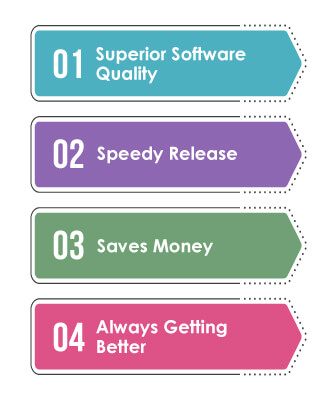Recommended Blogs
Decoding QAOps: Unleashing the Power of Quality Assurance Operations in 2025

- What is QAOps?
- What Are the Benefits of QAOps?
- What are the Tools Used in QAOps?
- How Does QAOps Differ from DevOps?
- What are the Benefits of QAOps in 2025?
- How to Move to QAOps
- What are the Real-World Use Cases of QAOps?
- Conclusion
- How Can TestingXperts Help?
“DevOps” has become a popular way to work in the changing world of software development, where speed, agility, and quality are very important. DevOps is a change in culture and technology that focuses on working together, automating tasks, integrating and delivering code all the time. But in the world of DevOps, there’s another process that is getting more and more popular and needs our attention: QAOps.
This blog post will talk about what QAOps is, what it can do for you, how it differs from DevOps, why it will be important in 2025, how companies may switch to QAOps, and whether QAOps is likely to be the next big thing in software development. The blog also talks about how TestingXperts, a top firm for software testing and quality assurance, may help you with your QAOps journey.
What is QAOps?
Quality Assurance Operations, or QAOps, is an extension of the DevOps mindset that makes sure that quality assurance processes are built right into the software development and delivery pipeline. It stresses how important it is to make sure that the software is of the greatest quality at every stage of the development process.
What Are the Benefits of QAOps?
QAOps brings quality checks into every stage of development, not just at the end. It helps teams catch issues early, speed up releases, lower costs, and keep software stable and reliable as it moves from idea to production.

The adoption of QAOps brings forth a host of benefits for organizations:
Superior Software Quality
QAOps is all about making sure that software is of excellent quality from the start. It doesn’t only look for errors at the end; it keeps an eye on quality all the time while software is being made. It means that users will have a better and more reliable experience with the software because there will be fewer mistakes and problems.
Speedy Release
QAOps speeds up the elements of building software that involve testing and checking. It’s like having a lot of machines do the boring work for you. It lets businesses get their software to users much faster, which is highly crucial in today’s fast-paced world where everyone wants the newest and best things right away.
Saves Money
Think about how much better it would be to notice a little hole in a boat while it’s still in the harbor. It’s far cheaper and easier to fix it before it becomes worse. QAOps performs the same thing for software: it finds bugs early on, when they are easier and cheaper to solve. It saves a lot of money that would have to be spent on significant repairs later.
Always Getting Better
QAOps isn’t only about writing code. It’s also about improving the people who write the software. It motivates groups to collaborate and learn from what they’ve done. It means that they are continually looking for ways to make their program better, and each time they do, it becomes better. It’s like always getting better at what you do.
What are the Tools Used in QAOps?
QAOps uses a variety of tools to automate testing, keep an eye on performance, and add quality checks straight to CI/CD pipelines. These tools help teams find problems early and keep feedback loops quick.
Test Automation Tools
- Selenium: A popular open-source framework for automating web application testing across different browsers and platforms.
- Appium: An open-source tool for automating mobile app testing on iOS and Android.
- Katalon Studio: A low-code automation platform supporting web, API, mobile, and desktop testing.
- Cypress: A JavaScript-based end-to-end testing framework designed for fast, reliable testing with easy setup for developers.
- Playwright: A Node.js library for automated cross-browser web testing, offering powerful automation and debugging features.
Performance Testing Tools
- Apache JMeter: An open-source tool for load testing and measuring the performance of web applications and services.
- Gatling: A developer-friendly load testing tool for testing web applications and APIs at scale.
- Locust: An open-source tool for user load testing that allows writing test scenarios in Python.
CI/CD and Orchestration Tools
- Jenkins: A widely used open-source automation server for building, testing, and deploying code with CI/CD pipelines.
- GitLab CI/CD: An integrated CI/CD tool within GitLab for automating builds, tests, and deployments.
- CircleCI: A continuous integration and delivery platform that automates software build, test, and release workflows.
- Docker: A containerization platform that ensures consistent testing environments across development, QA, and production.
- Kubernetes: An orchestration tool that manages containers, making it easier to scale and automate deployments.
Monitoring and Reporting Tools
- Allure Report: A flexible, lightweight test report tool for creating clear, visual test execution reports.
- TestNG: A testing framework for Java that supports reporting, parallel execution, and easy test configuration.
- Prometheus: An open-source monitoring system often used to track application and infrastructure metrics alongside automated tests.
How Does QAOps Differ from DevOps?
Both QAOps and DevOps are ways to improve the processes of developing and delivering software. However, they focus on different parts of the development lifecycle:
Quality at the core
In DevOps testing services, the collaboration is mainly between the development and operations teams, broadly ensuring the final product is free of glitches. Here, quality or QA is part of the development process and assumes a ‘secondary’ role in the larger scheme of things.
In a DevOps testing strategy, the DevOps professionals are mostly developers, with testers playing a smaller role, and people from the operations team. So, even if the focus is on quality, the QA specialists stay in the background. The operations team mostly talks to and works with the QA team to make sure that products are always delivered in QAOps.
In this case, QA is not part of the development team; it is nonetheless an equal partner in the whole value chain. The main goal of QAOps testing is to always provide better client experiences.
Cultural shift
The main thrust of DevOps is to ensure the software is deployable at any point in time with new features in place. Here, every stakeholder should act as part of a single team working toward a common goal. DevOps calls for the development and operations team to function as a single unit aimed at delivering business value across the value chain.
In QAOps, the main thrust is to ensure the quality of the application in terms of its performance, scalability, functionality, security, and usability, among others. And since the singular focus in QAOps testing is on achieving the quality of the software application along with the speed of continuous delivery, the quality of the application is of the highest standard.
How Does QAOps Differ from DevOps?
Aspect |
DevOps |
QAOps |
| Primary Roles | Developers and Operations | QA specialists, working closely with Dev and Ops |
| Focus | Deployment speed | Ensuring software quality |
| Emphasis | Automation of development, deployment, and monitoring | Quality assurance practices |
| Collaboration | Dev and Ops collaborate closely for a smooth workflow | QA integrates with Dev and Ops for quality assurance |
| CI/CD Implementation | Strong emphasis on CI/CD pipelines | Focuses on early issue identification |
| Infrastructure | Embraces Infrastructure as a Code (IaaC) | Emphasizes rigorous testing strategies and tools |
What are the Benefits of QAOps in 2025?
Although it is quite new, QAOps is an emerging trend that allows the automation of processes between software development, IT, and QA to deliver software faster and with better quality. QAOps brings to attention the fact that quality should be a vital part of the development lifecycle and that QA and development teams should unite to create the best product for consumers. Quality assurance and test engineers are essential for a successful delivery model.
QAOps will play an important role in the future of software testing where the speed of delivery doesn’t impact negatively on the quality of software.
How to Move to QAOps

Moving to QAOps takes a lot of planning and work. Here are some things to think about:
• Assessment: Look at your present development and QA procedures to find areas where they could be better.
• Tooling: Buy automation and testing tools that help with QAOps.
• Training: Make sure your teams have the right skills and training to do QAOps well.
What are the Real-World Use Cases of QAOps?
QAOps runs regression tests on every code update automatically. It means that any new problem that breaks features that are already there will be found right away. It maintains releases reliable and keeps teams from being surprised late in the cycle.
Automated Regression Testing
QAOps automatically runs regression tests on code changes. It means new bugs that break features are caught immediately. It protects teams from late surprises and stabilizes releases.
Constant Performance Testing
In the CI/CD pipeline, performance and functional tests run simultaneously. It helps teams see how their apps handle real-world traffic before launch, preventing production slowdowns or crashes.
Left-shift security testing
Early development includes security checks. Team members can identify weaknesses before they become big issues, improving compliance and data security.
Parallel Cross-Browser Testing
QAOps tests several browsers and devices simultaneously. It ensures the program runs across all devices and browsers without slowing the release schedule.
Real-Time Defect Reporting
When automated tests don’t work, detailed reports of the problems are made and given out soon away. Developers can see what broke, where it happened, and why, which speeds up updates and keeps the feedback loop tight.
Automated API Testing
APIs are tested automatically as part of the build process. It verifies that data flows stay intact, services work well together, and any change that breaks integrations is flagged before reaching production.
Conclusion
QAOps is a new version of the DevOps movement that focuses on quality in software development. Many firms are now using QAOps as a main part of their efforts to improve their software. It’s hard to determine what will happen in the future, but one thing is certain: there will still be a demand for good software in 2025 and beyond.
It’s smart to use QAOps because technology is moving so quickly. It makes it possible to build better software, deploy it faster, and make customers happier. QAOps is going to be a big part of software development in 2025 and beyond since it can improve software quality, speed up delivery, and cut costs.
How Can TestingXperts Help
At TestingXperts, we specialize in elevating software quality through our expertise in quality assurance services. As your trusted partner on the QAOps journey, we offer seasoned teams ready to guide you through implementing QAOps practices tailored to your needs. Our experienced professionals excel in selecting the right tools and establishing precise processes to ensure your software products meet the highest quality standards. From the initial setup to ongoing support, we’re dedicated to optimizing your development cycle.
By leveraging QAOps, we pave the way for a seamless fusion of quality and speed. We focus on enhancing your software development capabilities, ensuring that each step, from design to deployment, is fortified with quality measures.
Discover more
Stay Updated
Subscribe for more info
